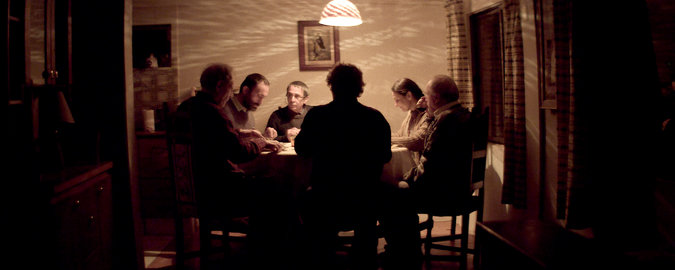‘the Club’ Sees the World through the Eyes of Damaged Souls
By A. O. Scott
Tom McCarthy’s “Spotlight,” deservedly nominated for a bunch of Oscars, examines evil from the outside, shining a beam of journalistic illumination at the abuse and corruption that festered within the Roman Catholic hierarchy for decades. “The Club,” the latest feature from the Chilean writer-director Pablo Larrain, looks at the same issue from the inside out, bringing the viewer into an uncomfortable state of intimacy with the perpetrators of hideous crimes. Not that the four men and one woman at the center of this clammy, unsettling film regard themselves that way, or look that way to their neighbors. The five of them live in a neat, yellow-painted house in a small coastal town, where they share meals and strolls along the beach and devote themselves to training their beloved racing dog. His winnings pad the household budget, and while their lives are hardly opulent, the members of this group of outcasts seem to enjoy a measure of peace. That changes when a new priest joins the club. Almost as soon as he arrives, a disturbed, raggedly dressed man who calls himself Sandokan (Roberto Farias) shows up outside the house and relates, at the top of his lungs and in pornographic detail, a story of sexual abuse. Violence ensues, and in its aftermath an official from the Vatican — a Jesuit named Father Garcia (Marcelo Alonso) — hangs around to investigate and to bring his disgraced colleagues into line. Father Garcia, lean and serious and relatively young, empties the liquor bottles, cuts back on the dog-racing and declares the clubhouse “a place of penance.” He presents himself as the representative of “a new church,” but though he institutes a program of spiritual healing, he doesn’t seem interested in transparency or justice. His reluctant charges suspect that his job is mainly to protect the image of the church, and to sweep away their contributions to its mission. These men speak openly, even righteously — though often through a veil of euphemism — about what they have done. Father Ortega (Alejandro Goic), who coerced poor women into giving up their babies for adoption by wealthier families, casts himself as a fighter for social justice. Father Vidal (Alfredo Castro) imagines his sexual predations as expressions of the purest kind of love, an eros that brings him closer to God than mere reproduction ever could. Mother Monica (Antonia Zegers), who appears at first to be both house mother and housekeeper, turns out to be more of a co-conspirator, a former nun with her own grim record of transgressions. Mr. Larrain, whose previous films (“Post-Mortem, “Tony Manero” and “No”) have dwelled on cruelty and moral corruption in Chile during the Pinochet dictatorship, has an acute sense of how socially sanctioned authority feeds individual sadism. Mr. Castro, a fixture in this director’s cinematic universe, is the perfect vessel for his pessimistic, unnervingly empathetic view of human nature. The actor’s sad eyes and weary countenance suggest both pathology and sensitivity. Like the murderer he played in “Tony Manero,” Father Vidal is a monster with a soul. “The Club” divides its attention among its characters, spending time with poor Sandokan as well as with his enemies. It is hard not to feel pity and disgust, and to absorb the lesson that people are awful, perhaps never more so than when they believe themselves innocent or good. Mr. Larrain and the cinematographer, Sergio Armstrong, use a deliberately ugly, gray-washed palette, blurring the edges of the figures on screen and making the world look as if it could only be seen through a layer of grime. There is power in this vision, but it can also feel forced, almost mechanical. “The Club” is most effective when it resists the imperatives of plot, compelling us to keep company with damaged souls who still believe in the possibility of grace. Toward the end, though, Mr. Larrain wills them toward a reckoning that is dramatically unpersuasive, crosscutting between acts of brutality that are simultaneously too grindingly literal and too obviously symbolic. You are left queasy and sad, but not much more. “The Club” is not rated. It is in Spanish, with English subtitles. Running time: 1 hour 37 minutes.
|
.
Any original material on these pages is copyright © BishopAccountability.org 2004. Reproduce freely with attribution.
